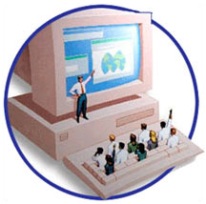IMPACT
VIRTUAL LEARNING- Design to facilitate teachers in the management of educational courses for their students, especially by helping teachers and learners with course administration.
- The system can often track the learners’ progress, which can be monitored by both teachers and learners.
- While often thought of as primarily tools for distance education, they are most often used to supplement face-to-face classroom.
ELECTRONIC LEARNING
- E-learning comprises all forms of electronically supported learning and teaching
- Utilized to reference out-of-classroom and in-classroom educational experiences via technology
- Essentially the computer and network-enabled transfer of skills and knowledge
- Delivered via the Internet, intranet/extranet, audio or video tape, satellite TV, and CD-ROM. It can be self-paced or instructor-led and includes media in the form of text, image, animation, streaming video and audio
SITUATION:
What are the impact of implementing electronic learning(e-learning) at education institution in Malaysia?
E-learning comprises all forms of electronically supported learning and teaching. The information and communication systems, whether networked learning or not, serve as specific media to implement the learning process. The term will still most likely be utilized to reference out-of-classroom and in-classroom educational experiences via technology, even as advances continue in regard to devices and curriculum. E-learning is essentially the computer and network-enabled transfer of skills and knowledge. E-learning applications and processes include Web-based learning, computer-based learning, virtual education opportunities and digital collaboration. Content is delivered via the Internet, intranet/extranet, audio or video tape, satellite TV, and CD-ROM. It can be self-paced or instructor-led and includes media in the form of text, image, animation, streaming video and audio. E-learning services have evolved since computers were first used in education. There is a trend to move towards blended learning services, where computer-based activities are integrated with practical or classroom-based situations. A learning management system (LMS) is software used for delivering, tracking and managing training/education. LMSs range from systems for managing training/educational records to software for distributing courses over the Internet and offering features for online collaboration. A LMS allows for teachers and administrators to track attendance, time on task, and student progress. LMS also allows for not only teachers and administrators to track these variables but parents and students as well. Parents can log on to the LMS to track grades. Students log on to the LMS to submit homework and to access the course syllabus and lessons.



No comments:
Post a Comment